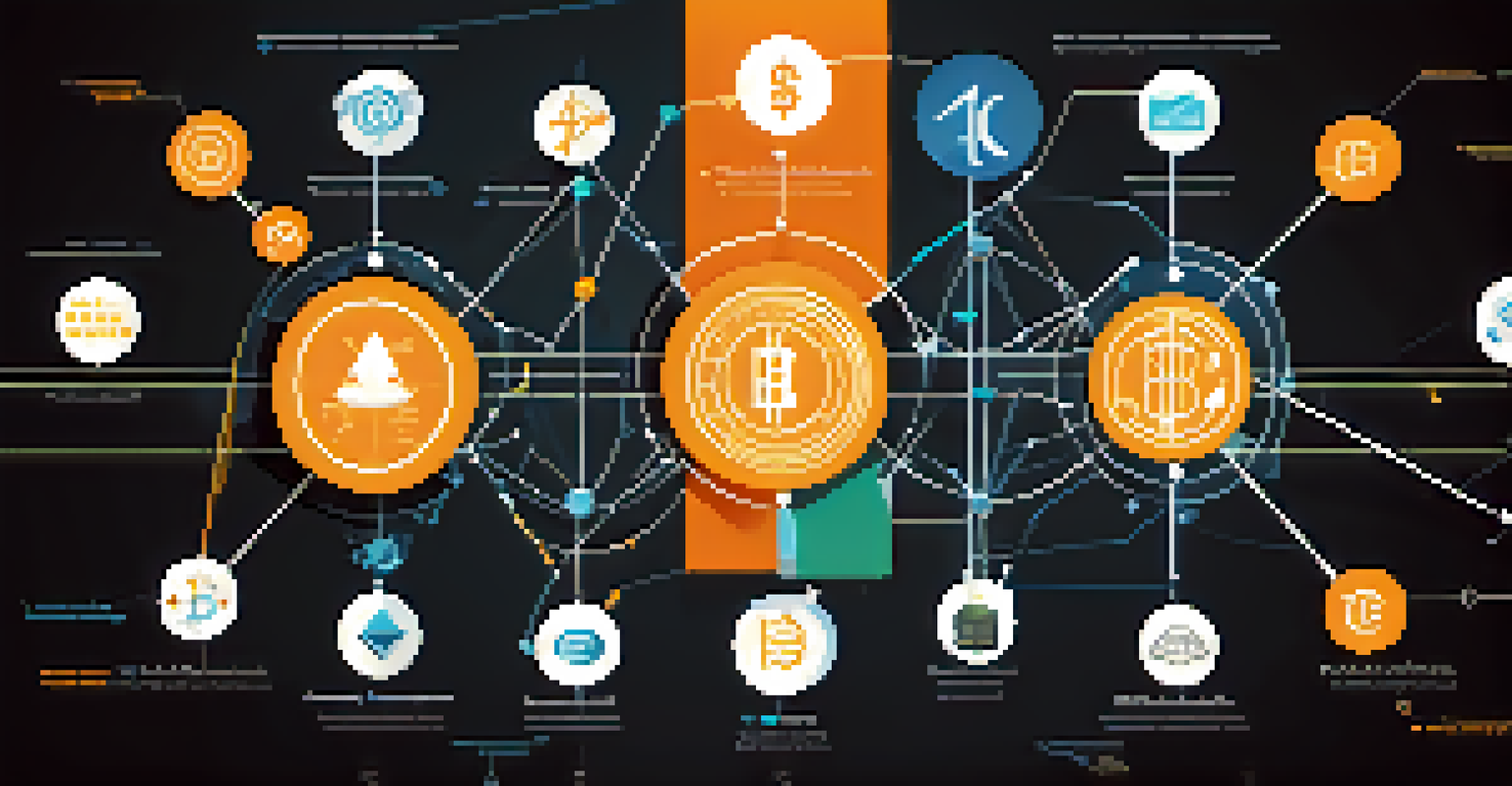Interoperability Solutions: Atomic Swaps and Beyond

Understanding Interoperability in Blockchain Technology
Interoperability refers to the ability of different blockchain systems to communicate and work together seamlessly. Imagine a world where you can easily exchange assets between different cryptocurrencies without the hassle of intermediaries. This is crucial as the blockchain ecosystem continues to grow, with numerous platforms emerging, each offering unique features and functionalities.
Interoperability is the key to unlocking the full potential of blockchain.
As blockchain projects expand, users are increasingly looking for ways to interact across various platforms. Without interoperability, these systems operate in silos, limiting their potential and usability. By facilitating communication between blockchains, interoperability solutions can enhance user experience and unlock new possibilities for innovation.
The need for interoperability is not just a technical challenge; it's also about enhancing user trust and adoption. When users can easily move assets or information across different platforms, they are more likely to engage with the technology. This growing demand has paved the way for solutions like atomic swaps, which enable direct peer-to-peer exchanges.
What Are Atomic Swaps and How Do They Work?
Atomic swaps are smart contracts that allow the exchange of cryptocurrencies from different blockchains without the need for a centralized exchange. Think of it as a secure handshake between two parties, where both must agree to the terms before the trade occurs. This process ensures that either both parties receive their assets, or neither does, hence the term 'atomic'.

The mechanics behind atomic swaps utilize hash time-locked contracts (HTLCs), which add a layer of security and trust. In simple terms, HTLCs ensure that the transaction must be completed within a certain timeframe, or it will revert back. This time-sensitive aspect helps in preventing fraud and encourages timely exchanges.
Interoperability Enhances Blockchain
Interoperability allows different blockchain systems to communicate, enabling seamless asset exchanges and unlocking new possibilities for user engagement.
Atomic swaps not only empower users to trade directly but also reduce fees associated with using centralized exchanges. By cutting out the middleman, users retain more of their assets during the transaction. This efficiency is one of the driving factors behind the growing popularity of atomic swaps in the cryptocurrency community.
Benefits of Atomic Swaps for Users
One of the primary benefits of atomic swaps is enhanced security. As transactions occur directly between wallets, users don’t have to worry about the risks of exchanging assets through a centralized platform. This direct approach significantly reduces the potential for hacks and theft, making it a safer option for traders.
Atomic swaps are the future of peer-to-peer cryptocurrency exchange.
Moreover, atomic swaps facilitate greater control over assets. Users maintain full ownership of their cryptocurrencies until the transaction is complete, minimizing the reliance on third-party services. This autonomy is increasingly appealing in a time when privacy and control are paramount for many cryptocurrency enthusiasts.
Additionally, atomic swaps can lead to lower transaction fees compared to traditional exchanges. By bypassing intermediaries, users save on costs, which can be particularly advantageous for those engaging in frequent trading. As the ecosystem evolves, these cost-effective solutions may become a standard for cryptocurrency transactions.
Limitations of Atomic Swaps to Consider
While atomic swaps offer numerous advantages, they are not without limitations. One significant challenge is the need for both parties to have compatible cryptocurrencies. This requirement can restrict the number of potential swap options available, making it less versatile for users who want to trade across diverse assets.
Furthermore, the technical complexity of executing atomic swaps can deter some users, especially those who are not tech-savvy. Understanding the intricacies of smart contracts and HTLCs may be overwhelming for beginners in the cryptocurrency space. Simplifying this process is essential for wider adoption.
Atomic Swaps Offer Secure Trading
Atomic swaps enable direct, peer-to-peer exchanges of cryptocurrencies, enhancing security and reducing reliance on centralized platforms.
Lastly, atomic swaps currently have a limited reach, as they primarily apply to a select number of cryptocurrencies. This limitation means that users may not always find the pairs they wish to swap. As the technology matures and more cryptocurrencies adopt interoperable features, this challenge may gradually diminish.
Beyond Atomic Swaps: Other Interoperability Solutions
As the demand for seamless blockchain interactions grows, various interoperability solutions have emerged beyond atomic swaps. One notable example is cross-chain bridges, which allow users to transfer assets between different blockchains using a secure linking protocol. These bridges enable a broader range of transactions and expand the possibilities for users.
Another innovative solution is the use of wrapped tokens, which represent a cryptocurrency on a different blockchain. For instance, Wrapped Bitcoin (WBTC) allows Bitcoin holders to utilize their assets on the Ethereum blockchain. This bridging technique enhances liquidity and fosters interaction between different blockchain ecosystems.
Additionally, protocols like Polkadot and Cosmos are designed specifically to facilitate interoperability between multiple blockchains. By creating a network of connected chains, these platforms aim to provide a more cohesive experience for users, allowing them to leverage the strengths of various blockchains in a unified manner.
The Future of Interoperability in the Blockchain Space
The future of interoperability in the blockchain space looks promising, with continuous advancements in technology and increasing interest from users. As more projects recognize the importance of seamless interactions, we can expect to see a growing number of interoperability solutions catering to diverse needs. This evolution will likely enhance user experiences and encourage broader adoption of blockchain technology.
Moreover, as regulations around cryptocurrencies become clearer, there may be more opportunities for collaborations between different blockchain platforms. These partnerships can lead to innovative solutions that further bridge gaps between ecosystems, creating a more interconnected landscape. This synergy will be essential for the maturation of the blockchain industry.
Future Solutions for Seamless Transfers
Emerging interoperability solutions, like cross-chain bridges and wrapped tokens, are set to expand the capabilities of blockchain interactions.
Ultimately, the drive for interoperability is about enhancing usability and creating a more inclusive financial ecosystem. As we move forward, the integration of atomic swaps and various interoperability solutions will play a crucial role in shaping the future of how we interact with digital assets.
Conclusion: Embracing Interoperability for Growth
In conclusion, interoperability solutions such as atomic swaps are transforming the way we conduct transactions in the blockchain space. By facilitating direct exchanges and enhancing security, these innovations are making cryptocurrencies more accessible and user-friendly. As the industry evolves, the importance of seamless interactions cannot be overstated.
Looking ahead, embracing interoperability will be vital for the growth and success of blockchain technology. The ability to connect different platforms and enable fluid asset transfers will not only enhance user experiences but also drive innovation across the sector. In essence, interoperability is the key to unlocking the full potential of blockchain.

As we continue to explore the various solutions available, staying informed and engaged with these developments will empower users to make the most of their cryptocurrency journeys. The future is bright for interoperability, and we are just beginning to scratch the surface of what’s possible.